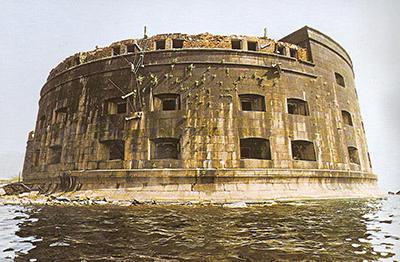The city of St. Petersburg is one of the world's tourist centers. But few know that its attractions are located not only on the mainland. In addition to museums, cathedrals, canals and palaces with parks, the Northern capital of Russia can also boast of ancient defensive structures. After all, Peter the Great, building a city under the very nose of the Swedes, had to take care of its safety from the sea. Therefore, in the Gulf of Finland, from the north and south, he ordered the construction of fortified fortresses on the islands. In case the enemy fleet breaks through the defenses of these strongholds, they should have been met by Fort Kronstadt. It is located on the island of Kotlin, only twenty kilometers from the coast of the mainland, on which St. Petersburg is located. Let's take a virtual tour of the last defensive chain of the city on the Neva.
The appearance of the first fort
The island of Kotlin was mentioned in chronicles before St. Petersburg appeared on the world map. The “Orekhov Peace Treaty” of the fourteenth century designates it as a border point between the Kingdom of Sweden and the Novgorod Republic. But after three hundred years the island became the property of its northern neighbors. The Swedes used Kotlin for the summer parking of their ships. In the autumn of 1703, Peter I ordered the construction of a fortress on the island. In one winter, Kotlin was fortified with an artificial embankment stretching from the mainland towards it. At this point, the Gulf of Finland is very shallow, and such a dam made it impossible for large vessels to pass. When navigation resumed in 1704, the Swedes found it impossible to get to the Neva Bay , and a fort was built on their island. In May, a fortress on a foreign land was consecrated and received the name Kronshlot (from the gol. "Royal Castle"). This was the first fort. Kronstadt as a fortified city appeared later. Kronshlot is located on the south coast of the island of Kotlin.

History of forts and the city of Kronstadt
Peter the Great wished this area became habitable. Therefore, workers, tradesmen and merchants began to move to the island. To encourage the nobility to move to Kotlin, Peter I ordered his palace to be built here. Unfortunately, this attraction has not been preserved to this day. But A. Menshikov settled on the island in the Italian Palace . In 1706, a redoubt Alexander the Trench was built on the western shore of Kotlin. And in October 1723, Peter the Great laid the solemn ceremony of Fort Kronstadt. The name is, again, translated from Dutch means “Royal City”. By this time, the island already had a lot of residential buildings. The king ordered the new fortress to encircle the entire city with protective walls, as well as shipyards. The construction of this citadel was completed in 1747.
Southern Forts of Kronstadt
The fortifications of the city were repeatedly rebuilt. This was required by developing military equipment. In order to resist the more formidable weapons of a possible enemy, the city authorities rebuilt the old and erected new forts. At present, there are twenty-one defensive structures in St. Petersburg. Seventeen of them are located on the islands of the Gulf of Finland. These Kronstadt forts, rising directly from the water (the photo of one of them in front of you) make an indelible impression on tourists. Conventionally, all these defensive fortresses are divided into northern and southern (depending on the location relative to the island of Kotlin). The first appeared, as we recall, Kronshlot. Later it was supplemented by seven more forts of the south side: First and Second, Milyutin, Emperor Pavel I, Battery, Prince Menshikov and Emperor Alexander I.
Northern Forts of Kronstadt
These fortresses were called upon to be the first to meet the onslaught of the enemy. There are seven of them too. In addition, in order to block the passage of the enemy fleet to St. Petersburg, they had to defend Kronstadt itself. Fort Severny No. 2 is still located on the island, while the KAD highway connected with Kotlin and the mainland. Two more fortresses are called Krasnoarmeyskaya and Pervomaiskaya.
Forts on the island of Kotlin
First of all, it was necessary to strengthen the city of Kronstadt. Therefore, in addition to the Central Citadel, encircling the village, auxiliary fortifications were erected. At first they were earthen ramparts (trenches). With the development of offensive technology, defense fortifications were also rebuilt. For tourists, Fort Citadel is of particular interest. It was built in 1724, and ten years later it was renamed Peter I. When the war broke out in 1808 with the Swedes, a double battery appeared in the south of the island, which is now called Fort Constantine. In the west of Kotlin, on the spit, the Reef rises. On the site of the earth redoubt in 1706, Alexander at the end of the nineteenth century was erected fort Shants. Kronstadt during the Second World War from these positions fired at German troops, who settled on the northern shore of the Gulf of Finland - from Zelenogorsk to Beloostrov.
Excursions to Kronstadt
The island of Kotlin, which is now populated, can be reached by road and through an underground tunnel. Now the fort city of Kronstadt has become a district of St. Petersburg. The fortifications on the island of Kotlin can be seen by yourself. Some of them are in poor condition due to frequent floods. To explore the forts of the north and south sides, you need to go on a water excursion. These guided boat tours are only available during the warmer months. Tours depart from Constantine Fort. But tourists are not landed ashore to inspect island fortifications.